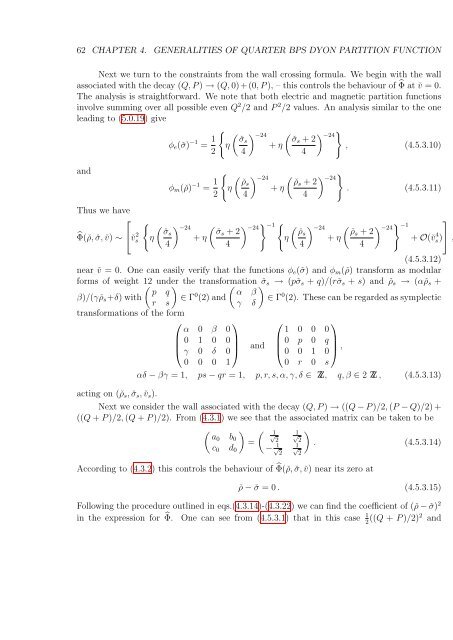PHYS08200604018 Shamik Banerjee - Homi Bhabha National ...
PHYS08200604018 Shamik Banerjee - Homi Bhabha National ...
PHYS08200604018 Shamik Banerjee - Homi Bhabha National ...
You also want an ePaper? Increase the reach of your titles
YUMPU automatically turns print PDFs into web optimized ePapers that Google loves.
62 CHAPTER 4. GENERALITIES OF QUARTER BPS DYON PARTITION FUNCTION<br />
Next we turn to the constraints from the wall crossing formula. We begin with the wall<br />
associated with the decay (Q, P ) → (Q, 0)+(0, P ), – this controls the behaviour of ̂Φ at ˇv = 0.<br />
The analysis is straightforward. We note that both electric and magnetic partition functions<br />
involve summing over all possible even Q 2 /2 and P 2 /2 values. An analysis similar to the one<br />
leading to (5.0.19) give<br />
and<br />
Thus we have<br />
⎡<br />
̂Φ(ˇρ, ˇσ, ˇv) ∼ ⎣ˇv s<br />
2<br />
{<br />
η<br />
φ e (ˇσ) −1 = 1 2<br />
φ m (ˇρ) −1 = 1 2<br />
( ) −24 ˇσs<br />
+ η<br />
4<br />
{<br />
{<br />
η<br />
η<br />
( ) −24 ˇσs<br />
+ η<br />
4<br />
( ) −24 ˇρs<br />
+ η<br />
4<br />
( ) } −24 −1 {<br />
ˇσs + 2<br />
η<br />
4<br />
( ) } −24 ˇσs + 2<br />
, (4.5.3.10)<br />
4<br />
( ) } −24 ˇρs + 2<br />
. (4.5.3.11)<br />
4<br />
( ) −24 ˇρs<br />
+ η<br />
4<br />
( ) } ⎤<br />
−24<br />
−1<br />
ˇρs + 2<br />
+ O(ˇv 4<br />
4<br />
s) ⎦ ,<br />
(4.5.3.12)<br />
near ˇv = 0. One can easily verify that the functions φ e (ˇσ) and φ m (ˇρ) transform as modular<br />
forms of weight 12 ( under ) the transformation ( ) ˇσ s → (pˇσ s + q)/(rˇσ s + s) and ˇρ s → (αˇρ s +<br />
p q<br />
α β<br />
β)/(γ ˇρ s +δ) with ∈ Γ<br />
r s<br />
0 (2) and ∈ Γ<br />
γ δ<br />
0 (2). These can be regarded as symplectic<br />
transformations of the form<br />
⎛ ⎞<br />
⎞<br />
α 0 β 0<br />
1 0 0 0<br />
⎜ ⎜⎝ 0 1 0 0 ⎟ ⎜ 0 p 0 q ⎟<br />
acting on (ˇρ s , ˇσ s , ˇv s ).<br />
γ 0 δ 0<br />
0 0 0 1<br />
⎟<br />
⎠ and ⎜<br />
⎝<br />
⎛<br />
0 0 1 0<br />
0 r 0 s<br />
αδ − βγ = 1, ps − qr = 1, p, r, s, α, γ, δ ∈ Z, q, β ∈ 2 Z , (4.5.3.13)<br />
Next we consider the wall associated with the decay (Q, P ) → ((Q − P )/2, (P − Q)/2) +<br />
((Q + P )/2, (Q + P )/2). From (4.3.1) we see that the associated matrix can be taken to be<br />
( ) (<br />
a0 b √2 1 1 ) √2<br />
0<br />
=<br />
. (4.5.3.14)<br />
c 0 d 0 √2<br />
− 1 √<br />
2<br />
1<br />
⎟<br />
⎠ ,<br />
According to (4.3.2) this controls the behaviour of ̂Φ(ˇρ, ˇσ, ˇv) near its zero at<br />
ˇρ − ˇσ = 0 . (4.5.3.15)<br />
Following the procedure outlined in eqs.(4.3.14)-(4.3.22) we can find the coefficient of (ˇρ − ˇσ) 2<br />
in the expression for ̂Φ. One can see from (4.5.3.1) that in this case 1 2 ((Q + P )/2)2 and

















